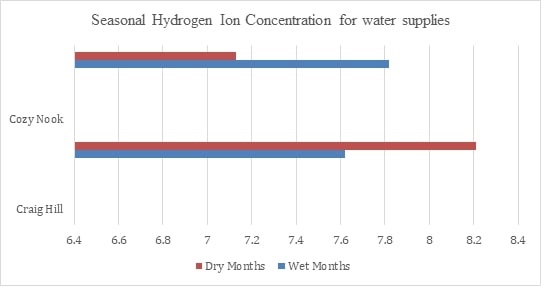A Seasonal Analysis of the Quality of and Safety of Drinking water harnessed from Roadside Entombments in East Rural, St. Andrew Jamaica

Abstract:
Due to the increase in population density
in urban areas and the uncertainty associated with the availability of municipal
water supplies, roadside water entombments have remained an important water
source for many residents of Jamaica. This research focused on the seasonal, quality
and safety of water harnessed from two non -municipal roadside water supplies.
The study employs a cross sectional quantitative approach and uses international
and national water quality standards as the benchmark. The aim of the study was to describe the seasonal
quality and safety of water harnessed from roadside water entombments in East
Rural St. Andrew Jamaica. The physiochemical, microbiological quality and safety
of the water supplies were assessed. Two microbiological samples were collected
from each source during the wet and dry months. In 100 % of the microbiological
samples the Total Coliform levels exceeded national and international limits of
Zero CFU/L for safe drinking water.
References:
[1] Alaska Department of
Environmental Conservation (2013). Alaska Water Quality Standards.
file:///C:/Users/User/Downloads/attachment-f-faq-turbidity-in-surface-waters-110813.pdf.
[2] Ambulkar, A., Lanfair,
Jordan K. and Schroth, Stephen T. (2018, June 18). Water
purification. Encyclopedia
Britannica. https://www.britannica.com/topic/water-purification.
[3] Assurity
Consulting (n.d.). What is important to
know about drinking water quality: Pseudomonas aeruginosa? Retrieved from https://www.assurityconsulting.co.uk/knowledge/guides/what-is-important-to-know-about-drinking-water-quality-pseudomonas-aeruginosa.
[4] Bawalan, R., 2012, Methods and Techniques in Water Stations in
the Philippines. Retrieved from
https://www.slideshare.net/RalphBawalan/methods-and-techniques-in-water-stations-in-the-philippines.
[5] BC Cook Articulation Committee. (2015). Food
Safety, Sanitation, and Personal Hygiene. Victoria, B.C.: BC campus. Retrieved
from https://opentextbc.ca/foodsafety/r for public purposes in bulk and not
packaged – definition.
[6] Birawida,
A. B., Selomo, M., & Mallongi, A., 2018, Potential hazards from hygiene,
sanitation and bacterium of refill drinking water at Barrang Lompo island
(water and food safety perspective). IOP Conference Series: Earth and
Environmental Science, 157, 012034. https://doi.org/10.1088/1755-1315/157/1/012034.
[7] Center for Disease and Prevention.
(n.d.). Assessing Access to Water &
Sanitation. Global Water, Sanitation and Hygiene (WASH). Retrieved June 22,
2017, from https://www.cdc.gov/healthywater/global/assessing.html.
[8] Center for Disease and Prevention.
(2009) Drinking Water Sources.
Retrieved from https://www.cdc.gov/healthywater/drinking/public/water_sources.html.
[9] Centers for Disease Control and
Prevention. (2020, November 18). Water
disinfection with chlorine and chloramine. https://www.cdc.gov/healthywater/drinking/public/water_disinfection.html
[10] Eils, L., 2000, Water Vending is here to Stay. Retrieved from
https://www.wqpmag.com/water-vending-here-stay.
[11] Gerba. C., Chaidez-Quiroz, C., Rusin, P.,
Naranjo, J., 1999, Microbiological
quality of water vending machines. Retrieved from
file:///C:/Users/User/Downloads/reprintwatervendingmachines.pdf.
[12] Government of Canada (2009). Guidelines for
Canadian Drinking Water Quality: Guideline Technical Document – Total Dissolved
Solids (TDS). Retrieved from
https://www.canada.ca/en/health-canada/services/publications/healthy-living/guidelines-canadian-drinking-water-quality-guideline-technical-document-total-dissolved-solids-tds.html.
[13] Magtibay, B. B., 2018, October 5, Study on Water Refilling Station - Water
Refilling Business. Business Diary Philippines. https://businessdiary.com.ph/835/water-refilling-station-study.
[14] National Archives and Federal
registration. (n.d.). eCFR::21 CFR
165.110 -- Bottled water. Code of Federal Regulations. Retrieved June 16,
2021, from
https://ecfr.federalregister.gov/current/title-21/chapter-I/subchapter-B/part-165/subpart-B/section-165.110.
[15] Norman, G., Parker, S., 2011, Business models for delegated management of
local water services: experience from Naivasha (Kenya). Retrieved from
https://www.pseau.org/outils/ouvrages/wsup_a_business_model_for_private_operation_of_local_water_networks_2011.pdf.
[16] Opryszko, M. C., Guo, Y., MacDonald, L.,
MacDonald, L., Kiihl, S., & Schwab, K. J., 2013, Impact of Water-Vending Kiosks and Hygiene Education on Household
Drinking Water Quality in Rural Ghana. Retrieved from
https://www.ncbi.nlm.nih.gov/pmc/articles/PMC3617848/.
[17] Puspitasari, E., 2018, ANALYSIS OF
THE FACTORS AFFECTING THE QUALITY OF THE CHEMICAL AND MICROBIOLOGICAL DRINKING
WATER AT THE DEPOT DRINKING WATER REFILL TULUNGAGUNG DISTRICT. JOURNAL FOR QUALITY IN PUBLIC HEALTH, 1(1), 104–112.
https://doi.org/10.30994/jqph.v1i1.10.
[18] Rahmitha, A., Utami, E. S., &
Sitohang, M. Y., 2018, Implementation of Geographical Information System for
Bacteriological Contamination Analysis on Refill Drinking Water Depot (Study in
Tembalang District). E3S Web of Conferences, 31, 06014.
https://doi.org/10.1051/e3sconf/20183106014.
[19] Sari, S. Y. I., Faisal, M.,
Raksanagara, A. S., Agustian, D., & Rusmil, K., 2020, Water Quality and
Factors Associated with Compliance of Drinking Water Refilling Stations as a
Choice for Middle–Low Urban Households in Developing Countries. Journal of Water and Environment Technology,
18(1), 27–36. https://doi.org/10.2965/jwet.19-037.
[20]The World Chlorine Council. (2008). Drinking water chlorination. https://www.worldchlorine.org/wp-content/themes/brickthemewp/pdfs/WCC_Policy_Paper_Water_Chlorination.pdf.

